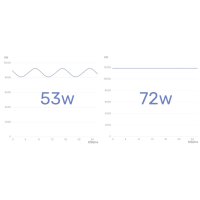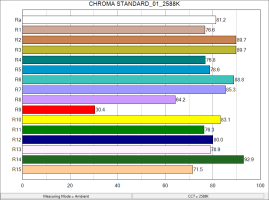itchaboyagain
Member
- Joined
- Oct 15, 2020
- Messages
- 48
My name is Derek and I'm a light bulb addict. Looks around the room nervously.
I've spent the last few months testing dozens upon dozens of lights to create a massive online database for health weirdos like us.
It's like if you went to buy food and it only had the macros and no ingredients listed, what gives?
Hopefully, this database will grow with time and no one will have to guess what their lights are "made out of".
So far, I've compiled a list of 93 lights (which will continue to grow), some of the very best on the market, for you to sort through.
This includes metrics on:
- CRI and TM-30 (Rf and Rg)
- SPDs (the actual spectral color graph)
- Flicker risk, index, and waveform graphs
- ASD (a measurement of how "realistic" a light is)
- Circadian Light (a relative measurement of how much potential a light has for entraining the circadian rhythm)
There's a section explaining these things more in-depth if you need help interpreting the database.
So this is version 1 and I think it's finally ready to share! It's definitely easier to navigate on a desktop, but it will still work on mobile.
 Explore the database here!
Explore the database here! 
I'd always heard that LEDs were capable of achieving less flicker than incandescents, which is true.
What I found though, was that halogens/incandescents over 72w don't flicker at all.
Apparently, the AC current is no longer capable of influencing the brightness levels of the tungsten filament.

Some of you may have heard of Sylvania Natural bulbs, they claim to utilize "TruWave" technology.

TruWave is supposed to get rid of the turquoise dip and blue spike found in normal blue LED-based phosphor bulbs.
Well, their 8 and 11w bulbs are just normal blue LED phosphor pump bulbs so they're straight up lying to consumers about those.
Here's what the 8 and 11w "TruWave" LEDs from Sylvania look like...

TruWave? More like LIEWAVE! Sheesh.
Anyways, the 15w actually does have the advertised spectrum, so that's cool.

As you can see the large blue spike and turquoise dip are greatly diminished.
Probably the most interesting lights I tested were the new Ultra Definition bulbs by Philips.
They're quite nice-looking bulbs with an average CRI of around 95, and the spectral graphs aren't bad either:

There is no large blue spike or turquoise dip!
While there is a large red spike, I'll take this over a blue spike any day, and since it helps round out the red output, skin tones will look better under this light than most others.
Well, I think that's enough for this post!
I go over a lot of this stuff in a lot more depth in my article on Best Full Spectrum Lights if you want to read more!
I've spent the last few months testing dozens upon dozens of lights to create a massive online database for health weirdos like us.
What is This?
The thing is, light is extremely important, but when you go to BUY lights, what does the box say? The color temperature and wattage, that's about it.It's like if you went to buy food and it only had the macros and no ingredients listed, what gives?
Hopefully, this database will grow with time and no one will have to guess what their lights are "made out of".
So far, I've compiled a list of 93 lights (which will continue to grow), some of the very best on the market, for you to sort through.
This includes metrics on:
- CRI and TM-30 (Rf and Rg)
- SPDs (the actual spectral color graph)
- Flicker risk, index, and waveform graphs
- ASD (a measurement of how "realistic" a light is)
- Circadian Light (a relative measurement of how much potential a light has for entraining the circadian rhythm)
There's a section explaining these things more in-depth if you need help interpreting the database.
So this is version 1 and I think it's finally ready to share! It's definitely easier to navigate on a desktop, but it will still work on mobile.
Some of the Findings!
I've found some interesting and cool things I'd like to share here as well:I'd always heard that LEDs were capable of achieving less flicker than incandescents, which is true.
What I found though, was that halogens/incandescents over 72w don't flicker at all.
Apparently, the AC current is no longer capable of influencing the brightness levels of the tungsten filament.
Some of you may have heard of Sylvania Natural bulbs, they claim to utilize "TruWave" technology.
TruWave is supposed to get rid of the turquoise dip and blue spike found in normal blue LED-based phosphor bulbs.
Well, their 8 and 11w bulbs are just normal blue LED phosphor pump bulbs so they're straight up lying to consumers about those.
Here's what the 8 and 11w "TruWave" LEDs from Sylvania look like...
TruWave? More like LIEWAVE! Sheesh.
Anyways, the 15w actually does have the advertised spectrum, so that's cool.
As you can see the large blue spike and turquoise dip are greatly diminished.
Probably the most interesting lights I tested were the new Ultra Definition bulbs by Philips.
They're quite nice-looking bulbs with an average CRI of around 95, and the spectral graphs aren't bad either:
There is no large blue spike or turquoise dip!
While there is a large red spike, I'll take this over a blue spike any day, and since it helps round out the red output, skin tones will look better under this light than most others.
Well, I think that's enough for this post!
I go over a lot of this stuff in a lot more depth in my article on Best Full Spectrum Lights if you want to read more!



